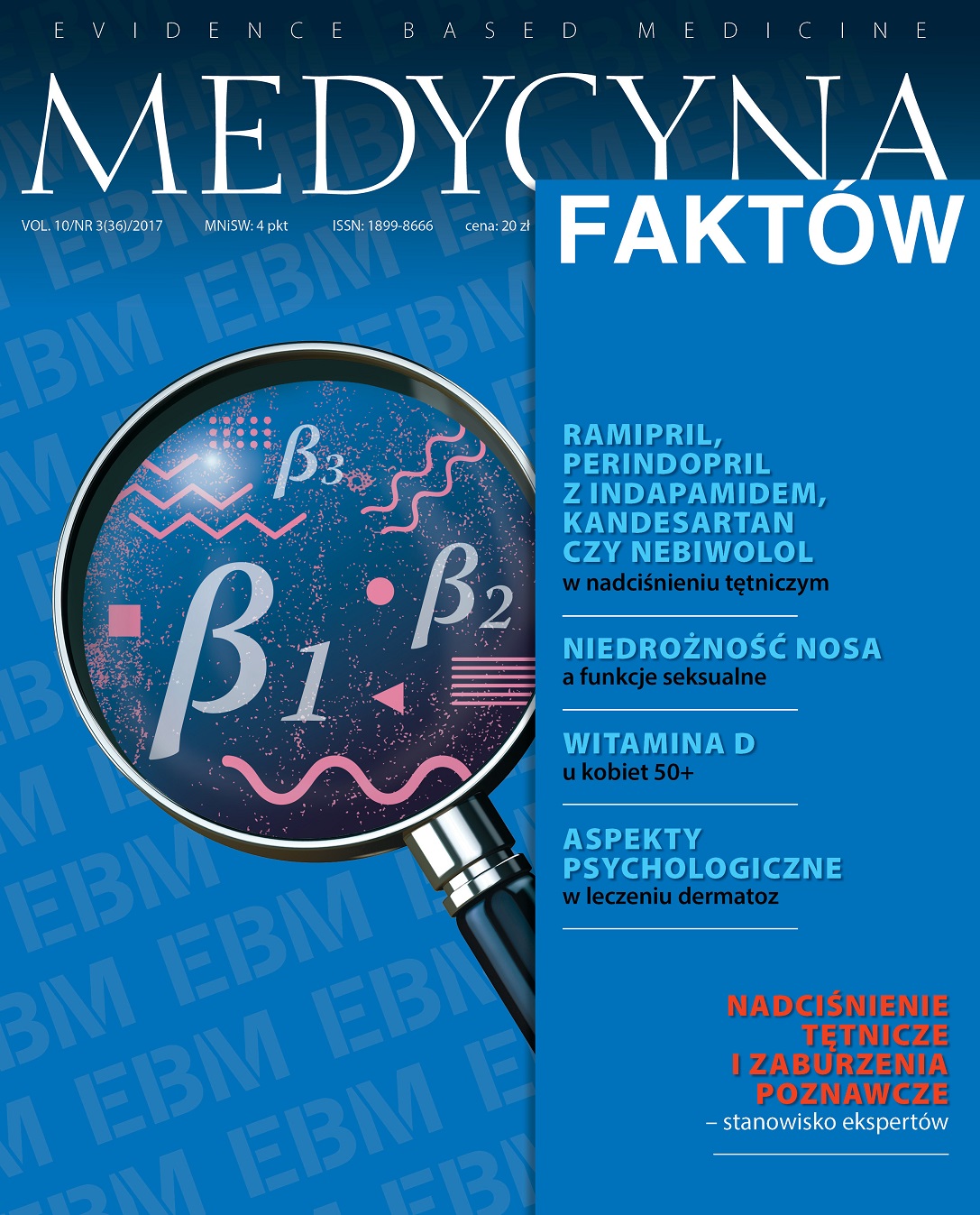Desloratadine – a modern antihistamine Review article
Main Article Content
Abstract
Desloratadine, due to its high efficacy and safety profile, meets the requirements of the modern second-generation antihistamine medicine in the treatment of allergic diseases. Owing to its affinity to the H1 receptor, it finds particular application in allergic rhinitis and urticaria.
Article Details
How to Cite
Krzych-Fałta, E., & Samoliński , B. (2017). Desloratadine – a modern antihistamine. Medycyna Faktow (J EBM), 10(3(36), 258-261. Retrieved from https://journalsmededu.pl/index.php/jebm/article/view/2135
Issue
Section
Articles
Copyright © by Medical Education. All rights reserved.
References
1. Samoliński B.: Raport Epidemiologii Chorób Alergicznych w Polsce. Warszawa 2011.
2. Samoliński B., Raciborski F., Lipiec A. et al.: Epidemiologia Chorób Alergicznych w Polsce. Alergologia Polska 2014; 1: 10-18.
3. Samoliński B., Sybilski A.J., Raciborski F. et al.: Prevalence of rhinitis in Polish population according to the ECAP (Epidemiology of Allergic Discorders in Poland) study. Otolaryngol. Pol. 2009; 63(4): 324-330.
4. Raciborski F., Kłak A., Czarnecka-Operacz M. et al.; EUP WG: Epidemiology of urticaria in Poland – a nationally-representative survey results. Postępy Dermatologii i Alergologii Polskiej [w druku].
5. Samoliński B., Arcimowicz M.: Polskie Standardy Leczenia Nieżytów Nosa (PoSLeNN). Alergologia Polska 2013; S1.
6. Zuberbier T., Aberer W., Asero R. et al.: The EAACI/GA(2) LEN/EDF/WAO Guideline for the definition, classification, diagnosis, and management of urticaria: the 2013 revision and update. Allergy 2014; 69: 868-887.
7. Zawisza E.: Leki antyhistaminowe III generacji w terapii pyłkowic. Alergia 2002; 2(13).
8. Bil J.: Desloratadyna – aktualne miejsce terapii alergicznego nieżytu nosa i pokrzywki. Kurier Medyczny, Alergologia 2017.
9. Wikipedia. Desloratadyna [online]; dostęp: 17.07.2017.
10. Weller K., Maurer M.: Desloratadine inhibits human skin mast cell activation and histamine release. J. Invest. Dermatol. 2009; 129: 2723-2726.
11. Charakterystyka Produktu Leczniczego – desloratadyna.
12. Paśko P., Rodacki T., Domagała-Rodacka R. et al.: Second generation H1 – antihistamines interaction with food and alcohol – a systematic review. Biomed. Pharmacother. 2017; 93: 27-39.
13. Sadowska-Woda I., Bieszczad-Bedrejczuk E.: Spektrum działania farmakologicznego desloratadyny. Alergia Astma Immunologia 2010; 15(4): 189-196.
14. Denham K.J., Boutsiouki P., Clough G.F. et al.: Comparison of the effects of desloratadine and levocetirizine on histamine-induced wheal, flare, and itch in human skin. Inflammation. Res. 2003; 52: 424-427.
15. Zheng D., Yang X.:Clinical observation on the therapeutic effect of desloratadine citrate disodium in the treatment of chronic urticarial and changes in IL4, IL18, IL23 and IL-33 levels before and after treatment. Pak. J. Pharm. Sci. 2017; 30(3(Special)): 1139-1142.
16. Brozek J.L., Bousquet J., Baena-Cagnani C.E. et al.: Allergic Rhinitis and its Impact on Asthma (ARIA) guidelines: 2010 revision. J. Allergy Clin. Immunol. 2010; 126(3): 466-476.
2. Samoliński B., Raciborski F., Lipiec A. et al.: Epidemiologia Chorób Alergicznych w Polsce. Alergologia Polska 2014; 1: 10-18.
3. Samoliński B., Sybilski A.J., Raciborski F. et al.: Prevalence of rhinitis in Polish population according to the ECAP (Epidemiology of Allergic Discorders in Poland) study. Otolaryngol. Pol. 2009; 63(4): 324-330.
4. Raciborski F., Kłak A., Czarnecka-Operacz M. et al.; EUP WG: Epidemiology of urticaria in Poland – a nationally-representative survey results. Postępy Dermatologii i Alergologii Polskiej [w druku].
5. Samoliński B., Arcimowicz M.: Polskie Standardy Leczenia Nieżytów Nosa (PoSLeNN). Alergologia Polska 2013; S1.
6. Zuberbier T., Aberer W., Asero R. et al.: The EAACI/GA(2) LEN/EDF/WAO Guideline for the definition, classification, diagnosis, and management of urticaria: the 2013 revision and update. Allergy 2014; 69: 868-887.
7. Zawisza E.: Leki antyhistaminowe III generacji w terapii pyłkowic. Alergia 2002; 2(13).
8. Bil J.: Desloratadyna – aktualne miejsce terapii alergicznego nieżytu nosa i pokrzywki. Kurier Medyczny, Alergologia 2017.
9. Wikipedia. Desloratadyna [online]; dostęp: 17.07.2017.
10. Weller K., Maurer M.: Desloratadine inhibits human skin mast cell activation and histamine release. J. Invest. Dermatol. 2009; 129: 2723-2726.
11. Charakterystyka Produktu Leczniczego – desloratadyna.
12. Paśko P., Rodacki T., Domagała-Rodacka R. et al.: Second generation H1 – antihistamines interaction with food and alcohol – a systematic review. Biomed. Pharmacother. 2017; 93: 27-39.
13. Sadowska-Woda I., Bieszczad-Bedrejczuk E.: Spektrum działania farmakologicznego desloratadyny. Alergia Astma Immunologia 2010; 15(4): 189-196.
14. Denham K.J., Boutsiouki P., Clough G.F. et al.: Comparison of the effects of desloratadine and levocetirizine on histamine-induced wheal, flare, and itch in human skin. Inflammation. Res. 2003; 52: 424-427.
15. Zheng D., Yang X.:Clinical observation on the therapeutic effect of desloratadine citrate disodium in the treatment of chronic urticarial and changes in IL4, IL18, IL23 and IL-33 levels before and after treatment. Pak. J. Pharm. Sci. 2017; 30(3(Special)): 1139-1142.
16. Brozek J.L., Bousquet J., Baena-Cagnani C.E. et al.: Allergic Rhinitis and its Impact on Asthma (ARIA) guidelines: 2010 revision. J. Allergy Clin. Immunol. 2010; 126(3): 466-476.

